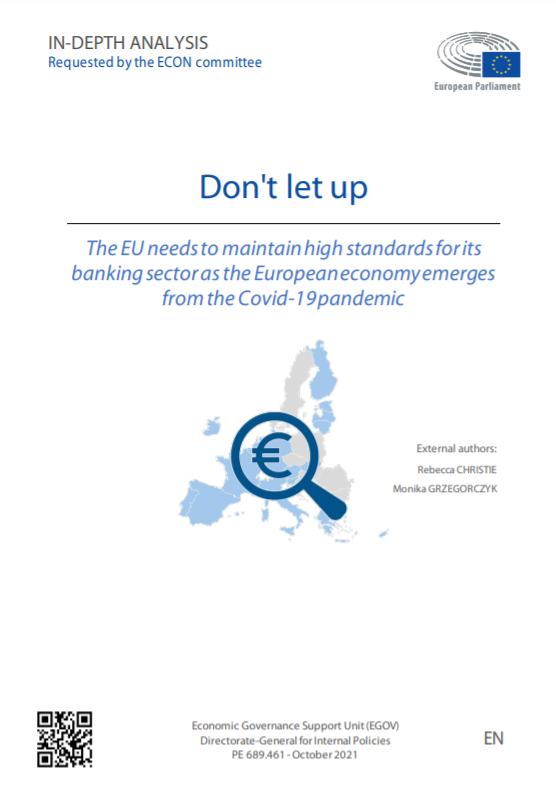Blog Post
European bank resolution plans are undermined by a lack of transparency
The discussions of the now-aborted merger of Germany’s two largest banks underlined supervisors’ concerns over creating banks that are too big or too complex to fail. While European banks are increasingly funded through securities that could be subject to a bail-in, transparency over how any resolutions would unfold is as yet very poor.
Three factors seem essential in ensuring the success of Europe’s framework for bank resolution: sufficient loss-absorbing capacity; adoption of organisational structures that allow critical functions of banks in resolution to be preserved while other parts are wound down in resolution; and cooperation with resolution authorities outside the banking union that reflect the extensive ownership linkages of European banks.
While banks have made some progress in raising funds that could shelter the taxpayer from the costs of a potential failure, it is very unclear whether they have adopted internal structures and governance that would make a resolution a plausible scenario.
All banks submit to their supervisor so-called recovery plans, which lay out how to restore viability in times of financial stress. When the ECB reviewed the plans of the largest euro-area banks last year it found that banks were vastly over-optimistic about their capacity to raise additional capital and liquidity in a crisis. These extra buffers would surely be even further eroded in any systemic crisis. Such plans are not public, but the Single Supervisory Mechanism (SSM) seems to foster some sharing of best practice in the industry.
On this basis, the Single Resolution Board (SRB) has already drafted initial resolution plans, which address the ‘gone concern’ stage of a bank that is no longer viable. The SRB’s 2019 work programme envisages that these plans will now be finalised for all banks under its remit, and that plans set by national bodies will be scrutinised (nearly 2,300 other banks need to develop such plans).
Barriers to ‘resolvability’
The SRM Regulation details elements of resolution plans which largely reflect principles put in place by the Financial Stability Board (FSB). Within the banking union, implementation is only now clarified in SRB policies. Key aspects should be:
- through what tools resolution would be achieved, and specifically whether the bank would remain largely intact or whether individual parts would be wound down or sold off;
- whether several or only a single resolution authority would be involved (given the extensive ownership stakes, including in emerging markets, a key question would be where bail-in capital is positioned, and what call local host-country authorities would have on such funds);
- which parts of the institution would be deemed critical in a restructuring, and which could be subject to a wind-down (critical functions are provided to third parties, and their disruption would impact the real sector and/or financial stability);
- how any resolution would be funded (market confidence that funding could be sustained throughout a resolution would, of course, depend on investors grasping the resolution scenarios and viability of the entity that emerges).
In its work with banks the SRB will now address any barriers to resolvability. Previous Bruegel research has highlighted that complex ownership structures (including ownership by other banks) and international operations would complicate any resolution. But very little is known about what obstacles to resolution the SRM has identified, and how it intends to fix them.
Transparency is essential
Markets of course take a keen interest in resolution scenarios, not least to gauge the risk to sub-ordinated funding that could be subject to a bail-in. But transparency is also in the public interest as it will make the resolution regime more effective.
Only once markets and other stakeholders can anticipate that resolution is credible, and which parts of a failing bank would not be deemed critical, will they offer funding in light of such risk. Otherwise the bank would still be perceived as too-big-to-fail, and the moral-hazard problems familiar from the past crisis would set in. In light of a resolution scenario contracts could be set up in such a way to ensure continuity.
The FSB already called on financial institutions to make their own recovery plans public. But for euro-area banks there has been very little transparency of recovery plans and even less for resolution plans. One insight came from the European Court of Auditors, which in its 2017 report criticised that resolution plans were late in materialising and did not meet many requirements from the ‘Single Rulebook’ of bank supervision. Resolution strategies appeared not to have been operationalised. Communication with stakeholders seemed slow and incomplete. Also, it seemed unclear how the SRB interprets the ‘public interest’ that justifies its intervention.
European practice is very different from the approach now proposed in the UK, and also the US, where the largest financial institutions with a balance sheet in excess of $50 billion need to submit living wills. Public versions of these plans are made available by the Federal Reserve. The bank itself drafts the resolution plan, though supervisors then publish feedback where necessary. This approach is designed to disseminate best practice in the industry.
Options for the SRB
Lack of transparency of resolution plans, and of the SRB’s own strategy for addressing barriers to resolvability, still bedevils the European quest to tackle ‘too-big-to-fail’. Banks remain large, in complex ownership structures and inter-linked. More openness would assist banks’ internal restructuring, and also industry reorganisation, including through cross-border mergers.
The SRB should become more open about its own standards, what barriers it has identified, and how it goes about addressing them. As a young institution which had to quickly establish its role in the banking union, the SRB may have decided against disclosure of potentially market-sensitive information. But the US experience has shown that banks can be asked to produce a public version of their crisis plans, and that it may be in their interest to do so. This would likely bolster confidence that risks to the taxpayer are indeed limited, and guide the industry to reorganise into a more crisis-resilient structure.
Republishing and referencing
Bruegel considers itself a public good and takes no institutional standpoint. Anyone is free to republish and/or quote this post without prior consent. Please provide a full reference, clearly stating Bruegel and the relevant author as the source, and include a prominent hyperlink to the original post.


















